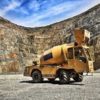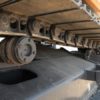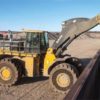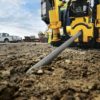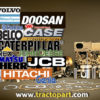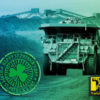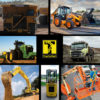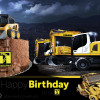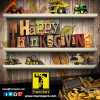PURCHASE CONSIDERATIONS FOR SMALL, MEDIUM SKID STEERS
Brand and price top the list for single most important factors in the acquisition of skid steers, followed by the machine’s key specification: rated operating capacity.

According to global market estimates supplied by LiuGong Machinery, worldwide skid steer loader (SSL) sales for 2016 are around 65,000 units. Consumption in Japan and China barely registers on the chart, and demand in Europe will likely be 5,000 units or so. The rest of the word, excluding North America, will account for some 15,000 units, leaving the lion’s share of consumption—perhaps 40,000 plus machines—for North America. The skid steer, obviously, remains a popular machine, despite increasing competition from compact track loaders and compact wheel loaders.
BRAND OVER BRAWN
(Single most important factor, % responding)
- Brand: 27%
- Acquisition price: 18%
- Rated operating capacity: 13%
- Dealer: 10%
- Auxiliary hydraulics: 9%
- Ease of service: 8%
- Lift-path configuration: 4%
- Engine horsepower: 2%
The popularity of the skid steer results, of course, not only from its ability to use a myriad of attachments, but also from its (comparatively) low acquisition cost and its range of sizes, allowing buyers to match machines to budgets, job sites, and the scope of work to be done. SSLs are classified by rated operating capacity (ROC), which is calculated at 50 percent of tipping load and typically varies from 700 to 4,000 pounds for today’s machines.
In North America, according to Gregg Zupancic, product marketing manager, John Deere Construction & Forestry, models with ROCs of 2,200 pounds and less (the subject of this report) have, in each of the past five years, represented about 60 percent of the total North American SSL market.
Gregg Warfel, division sales manager—compact, Terex Construction Americas, adds detail. “The most popular sizes of skid steer loaders right now continue to be those with operating capacities of 1,750 to 2,000 pounds, and vertical-lift models [compared with radial-lift models] are the most popular. These units are ideal for rental applications, and they are light enough to be trailered with other equipment.”
Says Jorge DeHoyos, senior project manager, skid steer and compact track loaders at Kubota, “What really stands out is that more than 42 percent of skid steers sold in the United States in 2015 had ROCs between 1,750 and 2,200 pounds. That number has been very constant the last several years. It’s the biggest chunk of the market by size class.”
But the numbers are subject to the market’s push and pull, says Jeff Brown, Caterpillar SSL product specialist. “We’re seeing more and more substitution of SSLs with their track-mounted counterparts—the compact track loader,” he says. “But even with that said, the market is still large, and the SSL still delivers the lowest owning and operating costs.”
According to DeHoyos, the industry saw a first-time phenomenon last year in the sales race between the SSL and the CTL (compact track loader).
“In 2015, for the first time ever, compact track loaders outsold skid steer loaders in the United States,” he says. “Some of that, however, might be attributed to the fluctuation of pricing, with the integration of Tier 4 models temporarily lowering the price gap between the product lines. This year should be interesting, but at present we see both product lines having an equal part of the pie in the compact-equipment industry.”
JCB’s George Chaney, SSL/CTL international sales manager, says that CTL sales outpaced SSL sales in North America in 2015 by about 12 percent. He assures buyers, however, that the skid steer is not about to go away. “The North American skid steer market is alive and well,” he says. “Yes, there has been rapid growth in the compact track loader market, but there will always be a preference for the skid steer on improved surfaces.”
$18.90
COST OF OWNERSHIP
ROC (lb.) Est. Avg. Price Hourly Rate* To 700 $16,400 $18.90 701-975 $19,900 $19.70 976-1,250 $23,530 $24.30 1,251-1,350 $29,640 $26.30 1,351-1,600 $38,470 $29.24 1,601-1,750 $35,400 $27.68 1,751-2,000 $40,000** $31.00** 2,001-2,200 $46,000** $34.00** *Hourly rate represents the monthly ownership costs divided by 176, plus operating cost. Unit prices used in this calculation: diesel fuel, $2.78 per gallon; mechanic’s wage at $52.33 per hour; and money costs at 3.75 percent. (**CE estimates)
Source: EquipmentWatch.com
BUYING CONSIDERATIONS
Given the range of SSL models available with ROCs of 2,200 pounds and less (we counted 72 among 14 North American suppliers), buyers have plenty of choice. Not included in the 14 suppliers is Wacker Neuson, which markets two SSL models in North America having ROCs of 2,350 and 2,800 pounds.
For some buyers, price is a prime factor in the purchase decision, and it seems that manufacturers are sensitive to that reality as they develop new lines.
John Deere’s new G Series models, for example, include the 312R (radial lift) and 314G (vertical lift), with respective ROCs of 1,550 and 1,760 pounds. These models, says the company’s Zupancic, are designed to be “simple and durable,” including some performance features of larger models, he says, but using basic technology (manual controls, for instance) and limiting options in the interest of reducing both price and complexity.
Buyers wanting more, says Zupancic, can choose the 316GR or 318G (1,750- and 1,945-pound ROCs, respectively), which have more horsepower, available joystick controls, and such options as a creeper mode and electronically adjustable rates for hydraulic and propel response.
Beyond price, however, a myriad of other choices confront buyers when choosing a machine. Fundamental among them is the machine’s physical size—to ensure that it can negotiate typical job sites with relative ease. That said, however, the experts advise not to skimp on the basics.
“When sizing a skid steer, it’s best to err on the side of a model capable of lifting more than you’d typically lift on a daily basis,” says Brad Stemper, solutions marketing manager, Case Construction Equipment. “It’s also important to specify an auxiliary-hydraulic package that exceeds the flow rates required by your regular attachments; higher flows allow running a wider selection of attachments if the need arises.”
Caterpillar’s Brown adds a caution about auxiliary hydraulics. “There are two important aspects of a high-flow system: flow and pressure. In some instances, only flow increases, which for some tools is okay and just affects tool speed. But for tools engaging harder materials, such as a cold planner, it might be important also to boost pressure for developing the necessary torque.”
Another essential consideration, says Terex’s Warfel, is horsepower. “Higher horsepower offers more dynamic force for pushing and production,” he says, “but also translates into a heavier machine. If there are weight restrictions on typical projects sites, the buyer might opt for a smaller machine.”
JCB’s Chaney adds that a machine’s operating weight is not only important for possible job-site restriction, but also for transport considerations.
Also of basic concern are the types of material the machine will handle. “You need to make sure the loader you choose can handle the material you’ll be moving,” says Warfel. “The weight of the material and how quickly it needs to be moved will influence the size of bucket required—the bigger the bucket, the bigger the loader.”
A further purchase decision is whether a radial-lift-path or a vertical-lift path front linkage would be most advantageous in a particular operation.
“A vertical-lift-path loader provides more lift capacity and more reach at full lift height, compared with a [similar-size] radius-lift-path machine,” says Jason Archbold, marketing manager at Bobcat Co. “Achieving maximum reach at full height makes it easier to clear high-sided trucks and hoppers and to perform jobs requiring repeated lifting at taller heights. Although the vertical-path loader might have a higher initial cost, its utilization can make it a better choice for particular operations—and these machines usually command higher resale prices.
“On the other hand,” says Archbold, “a radius-lift-path loader raises the load in an arc that provides maximum reach at truck-bed height. A radius machine excels at jobs with mid-range or lower working heights, such as dumping material over a wall, backfilling, loading and unloading flatbed trucks, leveling, and grading.”
Case’s Stemper adds that radial-lift machines are ideal for ground-engaging applications and typically feature better breakout, digging, and prying forces. Visibility also tends to be a bit better with the radial configuration, he says, due to the positioning of the loader arms and less structure to the rear of the machine.
Other features to consider, says Billy Wong, chief engineer for LiuGong, are two-speed travel and hydraulic couplers. “If the machine often changes job sites,” he says, “a two-speed system is indispensable, and if the machine frequently changes attachments, a hydraulic coupler can be a well-chosen option.”
Caterpillar’s Brown reminds buyers, however, that “two-speed travel is great, but without ride control, the machine can be uncomfortable to use at top speed.”
In many instances, buyers also have a choice of implement and steering controls, ranging from hand/foot systems, to hands-only, to electro-hydraulic joysticks with selectable patterns, to systems that allow switching implement control between foot pedals and hand levers, such as Bobcat’s Advanced Control System.
Although the trend seems to be toward single-lever control of steering and implements, a significant number of operators seem still to prefer the hand/foot system. John Deere’s Zupancic observes that some operators prefer the hand/foot system over joysticks in smaller, short-wheelbase machines, because the stiffer ride of these small units can result in inadvertent joystick (and front-linkage) movement as the operator naturally grips the lever during operation.
Another fundamental consideration is tire selection, which ranges from solid types for puncture-prone environments to pneumatics with all types of designs and levels of quality. “Repeat skid-steer buyers are learning the value of purchasing higher-spec, higher-quality tires and wheels,” says JCB’s Chaney. “Choosing tires with a stiffer sidewall, deeper tread pattern, and premium rubber compounds can greatly increase tire life, proving an overall better value.”
One final item—telematics. Based on available information, Caterpillar models are so equipped, and Case and John Deere have systems available (the John Deere system is a dealer-installed option at this point). JCB, says Chaney, is just beginning to integrate the company’s branded telematics system (Livelink) into its skid steer loaders.
Case’s Stemper says that SSL customers choosing the company’s SiteWatch system use it primarily to monitor idle time. “Operators frequently park a skid steer to perform other tasks and simply leave the machine running,” he says. “There are productivity conclusions that can be made by monitoring idle time.”
source: http://www.constructionequipment.com/purchase-considerations-small-medium-skid-steers
